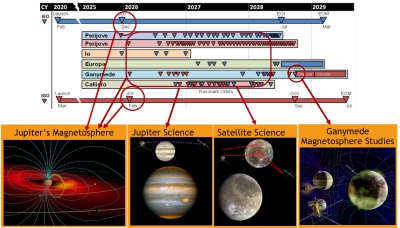Mission Scenario and Operations
Launch
The two spacecraft are planned to be launched in 2020 on two separate launch vehicles from different launch sites. They will reach the Jupiter system in 2026 and spend at least three years conducting observations of the Jovian atmosphere, magnetosphere, moons and rings. The baseline launcher for JGO is an Ariane-5 and the baseline launcher for JEO is an Atlas V 551.
JGO mission phases
After launch, JGO will use a ballistic trajectory with Venus-Earth-Earth gravity assist manoeuvres, to reach Jupiter. Jupiter Orbit Insertion (JOI) will mark the start of an 11 month Jupiter science phase followed by a 13 month Callisto science phase with Ganymede Orbit Insertion (GOI) to follow in 2028. At Ganymede, the combined elliptical and circular orbit science phases will last up to 15 months. JGO will ultimately perform a controlled impact on the surface of Ganymede before running out of orbit maintenance fuel. The figure below shows the timeline of the mission in which the JGO timeline and flybys are shown in red and those for JEO in blue.
 |
|
Diagram of a notional timeline for EJSM-Laplace, assuming JEO and JGO are launched one month apart in 2020. (Click on the image for further details.) Credit: ESA/NASA |
Different phases of the mission provide a variety of observation opportunities (see the table below for some examples). The scientific focus of the mission will evolve from the study of the Jovian atmosphere and magnetosphere in the Jupiter orbit phase, through the glimpses of Callisto during flybys, to detailed investigation of Ganymede, its magnetosphere and exosphere, and their interactions with the Jovian environment.
| Science phases of the ESA-led Jupiter Ganymede Orbiter | |||
| Phase & duration | Orbit & events | Science activity | |
| 1 | Cruise 5.9 years |
Gravity assists at Venus and Earth (twice) | |
| Jupiter Tour | |||
| 2 | Jupiter orbiter ~365 days |
Elliptical orbit 13 × 245 RJ (Jupiter radii) 7 Ganymede swingbys 2 Callisto swingbys |
|
| 3 | Jupiter -Callisto orbiter ~388 days |
Elliptical orbit around Jupiter with 1:1 and 2:3 resonances with Callisto 9 Callisto swingbys at altitude of 200 km |
|
| 4 | Transfer to Ganymede ~240 days |
Elliptical orbit around Jupiter 2 Ganymede swingbys |
|
| Ganymede Tour | |||
| 5 | Ganymede elliptical orbit (GEO) 120 days |
Evolution from elliptical (200×10000 km) to high altitude (5000 km) circular orbit and back to elliptical orbit at Ganymede |
|
| 6 | Middle altitude (500 km) circular orbit (GCO-500) 120 days |
Circular quasi-polar orbit at 500 km altitude |
|
| 7 | Low altitude (200 km) circular orbit (GCO-200) 60 days |
Circular quasi-polar orbit at 200 km altitude | |
| Note: In the case of a 2022 launch the cruise phase will be about 7.5 years. | |||
JEO mission summary
JEO will also use a ballistic trajectory with Venus-Earth-Earth gravity assist manoeuvres to reach Jupiter. Jupiter Orbit Insertion (JOI) will mark the start of a 30 month Jovian system tour followed by a 9 month Europa science phase after Orbit Insertion (EOI) in July 2028. The orbiter will ultimately impact the surface of Europa after succumbing to radiation damage or running out of orbit maintenance fuel. Further details can be found at the NASA JEO website.
Ground segment
The baseline Mission Operations Centre (MOC) for JGO will be provided by ESA's European Spacecraft Operations Centre (ESOC) and supported by the ESA ground station network (ESTRACK). JGO science operations are planned to be conducted from ESA's European Space Astronomy Centre (ESAC). For JEO, a standard Mission Operations System (MOS) will be developed by NASA's Jet Propulsion Laboratory (JPL), and NASA's Deep Space Network will be used for tracking support.
Tracking coverage for both spacecraft will vary according to mission phases. JGO flight operations design will be based on one 8-hour-long track per day during the science phase, but less frequent tracking during the six year cruise phase to Jupiter. For JEO, daily tracking coverage based on one track per day is assumed for all phases of the mission, with the exception of the first 105 days in orbit at Europa, when continuous 24-hour coverage is foreseen.
